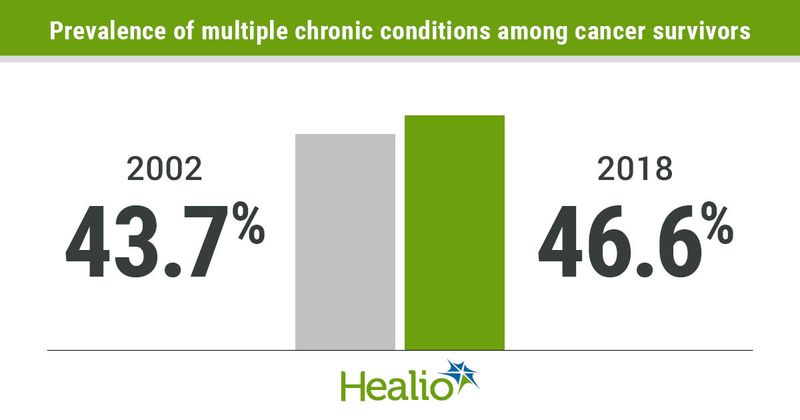Chronic diseases increasingly common among adult cancer survivors
The number of adult cancer survivors in the United States with comorbid illnesses and multiple chronic conditions has increased considerably since 2002, according to study results published in Cancer.
Aggressive interventions for risk reduction and optimal management of comorbid conditions could benefit the cancer survivor population, researchers noted.

“As a clinician, I see [patients with cancer] and survivors every day in my daily practice. One thing I realized is that not everyone was perfectly healthy when they received their cancer diagnosis — in fact, most patients have comorbid illnesses,” Charles Jiang, MD, MPH, researcher in the department of medicine at Roswell Park Comprehensive Cancer Center, told Healio. “These comorbidities compromised the patients’ outcomes during and beyond their cancer treatments; therefore, it is important to understand the changes in the burden of comorbid illnesses among cancer survivors on the population-level, so that every health care provider can be prepared to provide better care to this rapidly growing cancer survivor community.”
Jiang and colleagues calculated the age-, sex-, race- and ethnicity-adjusted prevalence and estimated the population sizes for various chronic conditions among 30,728 cancer survivors included in National Health Interview Surveys from 2002 to 2018.
Results showed increasing trends in the prevalence of hypertension, diabetes, kidney disease, liver disease and morbid obesity among cancer survivors. Conversely, trends for ischemic heart disease, chronic obstructive pulmonary disease and hepatitis decreased.
Additionally, the proportion of cancer survivors with multiple chronic conditions increased from 4.7 million (43.7%) in 2002 to 8.1 million (46.6%) in 2018, with the increase most pronounced among cancer survivors aged between 18 and 44 years.

“Our findings showed that in most subgroups, multiple comorbidities among cancer survivors grew at similar rates as individuals without a cancer history. We posit that the overall increase is less likely related to cancer treatment but rather is linked to the increasing trend of preexisting comorbidities and poorly controlled lifestyle factors, such as diet and physical activity, among the general population,” Jiang said. “Meanwhile, young adult cancer survivors demonstrated a significantly rapidly increasing prevalence of multiple chronic conditions compared with their noncancer peers. It is concerning that these patients have longer life expectancies than older survivors, but more financial hardship and difficulties accessing high-quality health care services.”
The results also suggest an urgent need to educate everyone, including patients with cancer, to pursue aggressive lifestyle modification before a possible cancer diagnosis, Jiang added.
“In addition, our health care communities may need to put more effort into better preparing non-oncologic health care providers how to take care of patients with a history of cancer,” Jiang said. “Subsequent research should focus on comorbidity prevention and risk factor interventions after cancer diagnosis. Further studies could also look into the comorbidities that we did not analyze here due to database limitations, such as HIV and dementia.”
For more information:
Charles Jiang, MD, PhD, can be reached at Roswell Park Comprehensive Cancer Center, Elm and Carlton streets, Buffalo, NY 14203; email: changchuan.jiang@roswellpark.org.

